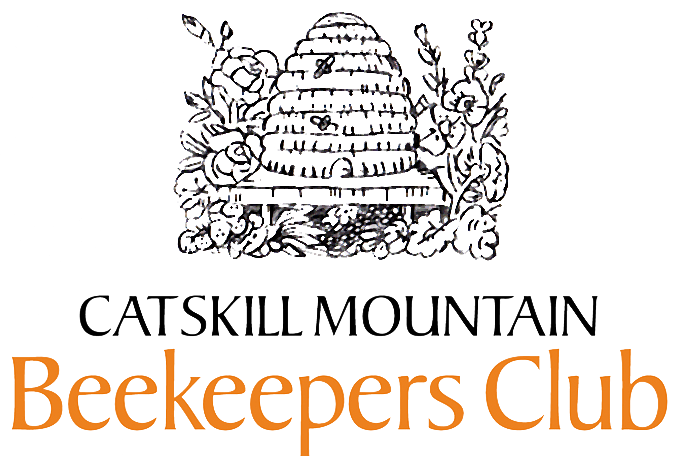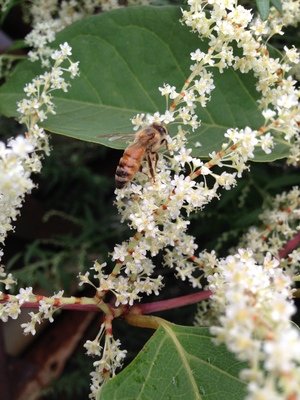Dick Johnson’s Honeybee Corner
How much land to feed one colony?
Conventional wisdom suggests that to nourish one colony of honeybees it takes one acre of blossoming trees, shrubs or flowers to thrive. No one really knows for sure and of course there are so many variables that no generalization can be assumed. It may be one acre in some regions but 5 or more elsewhere. For almond pollination two colonies per acre is needed for a well-pollinated crop. Crop insurance policies often require this rate before they pay any claims for a poor crop. You can’t go to a store and buy a bag of “Purina Bee Chow” although beekeepers do occasionally feed supplements when their hives do not have sufficient natural forage. Sugar syrup is fed to bees to provide calories to help the bees to survive. For them to raise and feed the brood they need protein –pollen or rich pollen substitute. This supplemental feeding is useful for short time only and is used especially when they need lots of bees ready to pollinate crops before the optimum bloom time.
How big is an acre? Visualize a football field (less the end zones) and you’ll see that a lot of blooming flowers are needed. Your bees will assure good backyard crop yield for your local, melons, squash, and apples but your garden furnishes only a tiny share of the nectar needed for feeding a colony. Whether one acre or five acres, this natural reservoir of nectar and pollen needs to be in full bloom from early spring to fall. Since there are no plants that are in continuous blossom all summer, the bees need to constantly seek out other fields that are in bloom. First spring pollen comes from willow, aspen, maple and alder but each of these are only good for a few weeks. Dandelions bloom about three weeks followed by clover. Next comes the fruit trees with lots of nectar and pollen but in a few weeks they are gone. Black locust, basswood and other trees can furnish nectar from millions of blossoms for a large tree but the bloom time is short. Even with these trees, an untimely rain may wash out most of the nectar. A bee yard surrounded by a forest does not yield a good honey crop. Dense shade from a conifer forest does not allow growth of sun loving nectar plants. Open meadowland, preferably with wetland nearby, are the best location for a bee yard and for good honey yield. Some native meadow blossoms sustain a longer nectar flow. The drought-resistant, yellow sweet clover bears tiny flowers, hard to see, but blooms from early July through September and produces a good honey surplus where it is grown. When they can’t find local blooms, bees sometimes travel up to five miles to find the food that they need.
A recent report from London highlights the need for adequate foraging area for a good honey yield. Beekeeping in cities has become popular in European cities as well as NYC. A London business group called “InMidtown” wants to supply more hives to new urban beekeepers to increase honey production. Although it sounds like a good idea, the London Beekeepers Assoc. opposes this and claims that there are already too many hives in the 600 square mile London region. With 3,337 registered hives, that figures to 5.5 colonies per square mile and already severely limits honey production to only 37 pounds per hive- way below the national average. The InMidtown group is busy planting honeybee forage in whatever space they can find but the beekeepers group prefers limiting more hives to increase the honey yield per hive and educating the public to sound beekeeping practices.
Beautiful, valuable, Fleeceflower
Honeybees are anxious to collect the ample nectar to produce rich, amber honey and beekeepers can count on harvesting a good crop. There are other useful benefits derived from this common roadside plant that can help the organic farmer. No one said that organic farming was easy- especially for the farmer to obtain the coveted approval of “certified organic” for use in marketing their products. Arbitrary requirements written by bureaucrats that never dug their hands in soil seem to control the regulations instead of experienced “ag” people. Difficulties include providing nutrients without chemical fertilizers and also battling insect and fungus problems without chemical pesticides.
Enter now a bunch of biotechnology companies such as AquaQuest, founded by an internationally recognized expert, Pam Marron, Ph.d. This researcher has received many global and US awards for her bio-friendly research. She has developed pesticides, weed control compounds, and a fungicide called “Serenade” to control powdery mildew, and bacterial blight for fruit culture. Pam has just developed a brand new biopesticide suitable for use by the organic food industry and this product is made from “fleeceflower”! Interested in entomology from childhood, Pam received her BS from Cornell and her Ph.d from North Carolina University.
Fleeceflower, (Polygonum cuspidatum) is a common weed grown in our region and is also known by many other names such as monkeyweed, elephant ears, Japanese bamboo, and knotweed. The tall bushy plant is currently in full bloom and its lacy, erect inflorescence is very attractive to honeybees. The amber honey harvested is considered as a premium honey and resembles both flavor and color of the prized buckwheat honey. In some regions it is so popular that it has been named “Red Bamboo”. In the west it has been used as a foraging crop for grazing animals and also since the roots can grow 3 meters deep it is used to PREVENT SOIL EROSION! The young stems of knotweed are edible as a spring vegetable similar to rhubarb.
The red wine popular in France and Spain has been credited with high antioxidant properties and seems to promote health despite high fat diets. The natural compound in red grape skins is “resveratrol” and this powerful antioxident material called phytoalexin is now being produced from knotweed replacing grape byproducts. The National Institute on Aging claims positive effects of resveratrol reducing cardiovascular disese and breast cancer. Knotweed also is a concentrated source of “emodin” widely used as a nutritional supplement to regulate bowel motility.
Beautiful fleeceflower is a source of many valuable natural products!
Honeybee Thermoregulation
Honeybees, like all insects, are “cold blooded”, meaning that they assume the surrounding ambient temperature. As individuals they can suffer and die when ambient temperature extremes occur. As a member of a well-populated honeybee colony however the bee can survive weather variations from -20°F to 114°F. Beekeepers need to understand the reaction of the honeybee colony to temperature changes to manage them effectively.
Flying temperature: Honeybees need at least 48 degrees to venture out on the front of the hive and start to fly. Active foraging starts as the day warms to 52 degrees. They will return to the hive when the air is below 50 degrees. Even at below zero, if a hive box is disturbed by banging (or a bear), some guard bees will fly out and sting just before they freeze solid. Competing with the honeybees for early nectar are the bumblebees that are able to fly and forage at a lower temperature of 40 degrees. During flight the wing muscles of honeybees attain a temperature of 104 degrees.
Colony in hive box temperatures: A healthy, well-populated colony within a hive box can maintain constant temperature despite outdoor extremes. In hot weather, bees collect water and fan wings to evaporate water to cool the hive. During high humidity and high temperature they also “hang out” like a beard on the front of the hive. In desert-like areas they can stay healthy and productive as
long as they have access to nearby water. During a cold winter, bees demonstrate an amazing ability to keep warm and survive even –20° periods as long as they have sufficient food for their “fuel”. Typical temperature measurements include: outside of box –20°, inside the 1 inch wood box a frosty 30°, and the outside layer of bees in the cluster at 40°. During the cold fall months, while there are no eggs or brood being raised, the center of the cluster is held to 57°. As early as the winter solstice, the queen may start to lay eggs and the bees need to consume greater volume of fuel (honey) to warm the cluster center to 94°.
Temperature is important during harvesting, extracting, storing and marketing of honey. As removed from the hive, honey is about 90° but it quickly attains ambient temperature and if not extracted promptly it may need to be re-warmed for better flow. If frames are below 80° during extracting, the yield may be less. During the “settling period” following straining, warming the honey to 117° helps to float wax particles for removal. This gentle warming does not damage the
flavor, or enzyme activity and the product can be marketed as “raw honey”. Honey sold in the commercial marketplace is usually heated to 160° to delay granulation and lengthen “shelf time”. This heat- treated product cannot be called raw honey and has lost flavor and enzyme activity.




